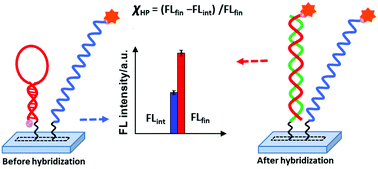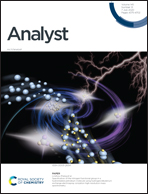A versatile fluorometric in situ hybridization method for the quantitation of hairpin conformations in DNA self-assembled monolayers†
Abstract
As the performance of hairpin DNA (hpDNA)-based biosensors is highly dependent on the yield of stem-loop (hairpin) conformations, we report herein a versatile fluorometric in situ hybridization protocol for examining hpDNA self-assembled monolayers (SAMs) on popularly used biochip substrates. Specifically, the ratio of fluorescence (FL) intensities of hpDNA SAMs (in an array format) before and after hybridization was adopted as the key parameter for performing such a determination. Upon confirming the existence of mixed and tunable DNA conformations in binary deposition solutions and efficient hybridization of the hairpin strands with the target DNA via gel electrophoresis assays, we tested the fluorometric protocol for determining the coverages of hpDNA in hpDNA/ssDNA SAMs prepared on gold; its accuracy was validated by Exonuclease I (Exo I)-assisted electrochemical quantitation. To further confirm its versatility, this FL protocol was adopted for quantifying hairpin conformations formed on glass and polycarbonate (PC) substrates. The molar ratios of surface-tethered hairpin conformations on the three different substrates were all found to be proportional to but less than those in the binary deposition solutions, and were dependent on the substrate morphology. The findings reported herein are beneficial for the construction of highly efficient DNA hairpin-based sensing surfaces, which essentially facilitates the creation of hpDNA-based biosensors with optimal detection performance.



 Please wait while we load your content...
Please wait while we load your content...